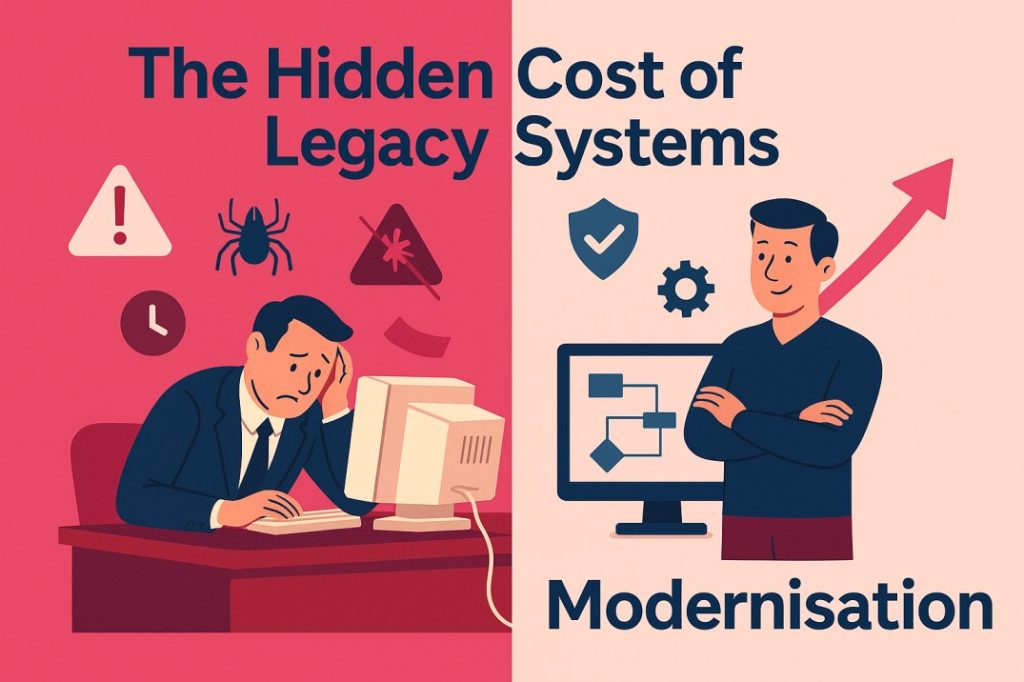In large enterprises, legacy systems often feel like the “safe” option. They’ve been in place for years, they’re familiar to staff, and replacing them seems expensive and risky. But beneath that perceived safety lies a staggering reality: legacy IT systems cost enterprises millions each year in inefficiency, maintenance, and lost opportunities.
According to Gartner, organisations spend 60–80% of their IT budgets simply maintaining existing systems, leaving little room for innovation. For enterprises competing in markets where agility and speed are everything, the true cost of legacy systems is no longer acceptable.
The Real Costs Enterprises Overlook
1. Maintenance and Support
Old systems require constant patching, security updates, and vendor support contracts. These hidden costs pile up year after year, eating into budgets that could be funding transformation projects. IDC estimates that maintaining legacy systems costs businesses up to five times more than running modern cloud-based equivalents.
2. Integration Nightmares
Legacy platforms were never designed to talk to today’s digital ecosystem. As enterprises adopt new tools, integration becomes a web of workarounds, middleware, and manual processes. The result? Data silos, duplicated effort, and error-prone workflows.
3. Security Risks
Older systems are prime targets for cyberattacks. The UK’s National Cyber Security Centre warns that unsupported software is one of the biggest enterprise vulnerabilities. Each year of delay increases both compliance risk and reputational risk.
4. Reduced Productivity
When staff have to rekey information into multiple systems or navigate outdated interfaces, productivity suffers. A McKinsey report shows that employees spend 1.8 hours every day searching for or re-entering information—time that translates into millions in lost labour.
5. Stifled Innovation
Legacy systems don’t just waste money—they prevent enterprises from innovating. AI, automation, and advanced analytics require clean, connected data. With outdated systems, enterprises miss opportunities for predictive insights, customer personalisation, and streamlined operations.
Case in Point: The Bank That Couldn’t Compete
One multinational bank clung to a 30-year-old core system, spending millions annually on maintenance. Integrating new digital products was slow, leading to months-long delays compared with fintech challengers. When the bank finally invested in a modern platform, it slashed time-to-market by 60% and cut IT maintenance costs by 40%.
The Path Forward
Modernisation, Not Rip-and-Replace
Enterprises often avoid transformation because they fear the disruption of ripping out core systems. But modernisation doesn’t have to be all-or-nothing. A phased roadmap—starting with data standardisation, then API-led integrations, then gradual migration—reduces risk while delivering early wins.
Focus on Data First
Before layering new systems, enterprises must clean and standardise data. Without a single source of truth, integration and automation fail. This foundational step is non-negotiable.
Harness Automation Bridges
Where legacy systems must remain temporarily, automation bridges (RPA, APIs, middleware) reduce manual work and maintain business continuity. This ensures enterprises see immediate efficiency gains while planning long-term migrations.
Build a Business Case on ROI
Enterprises should frame modernisation not as a cost but as an investment. When leadership sees how legacy systems erode productivity, block innovation, and create compliance risks, the ROI of transformation becomes clear.
The Bottom Line
Legacy systems might feel safe, but they’re a hidden drain on enterprise performance. They bleed budgets through maintenance, frustrate staff with inefficiency, and prevent innovation at a time when speed and agility are everything.
Enterprises that tackle modernisation strategically—focusing on data, leveraging automation, and rolling out change in phases—gain a double advantage: reduced costs today and the agility to compete tomorrow.
The question isn’t whether enterprises can afford to modernise. It’s whether they can afford not to.

